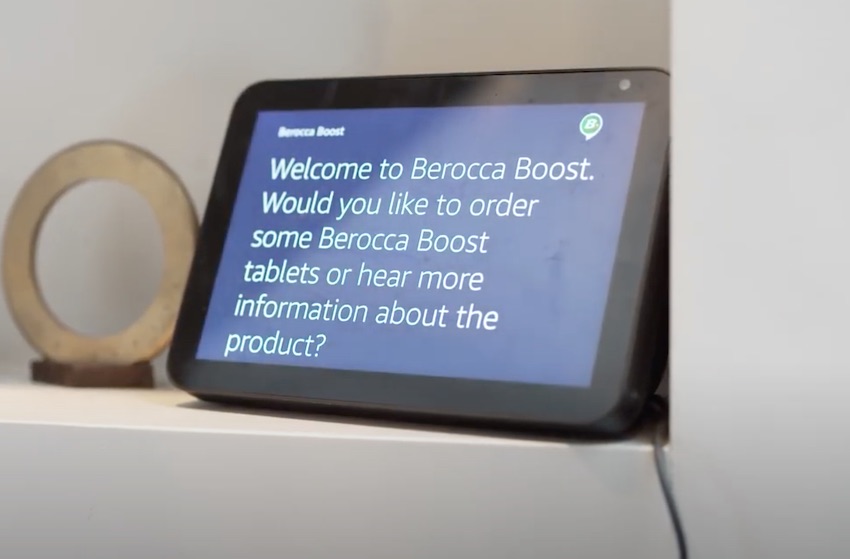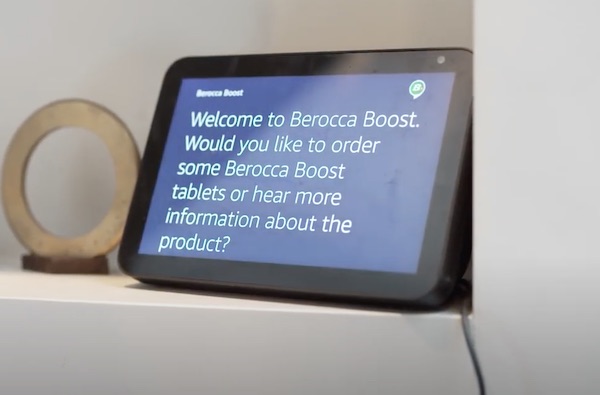Bayer’s Berocca Boost Launches Voice Commerce Radio Ad Campaign Using Beta Version of Amazon Alexa Shopping Cart
Bayer Consumer Health’s Berocca revealed Friday that it is running a new ad format for Amazon Alexa designed to drive sales conversions for its Berocca Boost vitamin tablets. The solution involves audio ads dynamically inserted during radio listening through Amazon Alexa devices. The ads conclude with a call to action to activate an Alexa skill. When consumers invoke the Alexa skill it offers information about the product and enables them to make a purchase by voice using their existing Amazon shopping account details.
The program was developed by a group of ad agencies and technology providers including A Million Ads, MediaCom, MullenLowe, and Say It Now. Ads are being delivered via Global radio station feeds being listened to through Alexa-enabled devices. As result, the ads are only heard by radio listeners that are known to be using an Alexa device at the time. This is where A Million Ads insertion technology is employed. The campaign is scheduled to run for four weeks in the UK starting February 12th.
“Marketing campaigns usually drive to one of three outcomes; transaction, lead generation, or experience delivery. Until now, a skill could only deliver lead gen or experience,” commented Say It Now CEO Charlie Cadbury in an interview with Voicebot. “Now transactional experiences can be served, enhancing the scope for adding the voice channel to integrated campaigns…It’s truly revolutionary in that channel to get end-to-end attribution from radio spots to transaction.”
Alexa Shopping Cart Beta
The solution is one of the earliest examples of the Alexa Shopping Cart beta program which includes ten partners globally. This program was first reported in the Voice Insider newsletter at the end of December. Say It Now, the 2019 winner of the UK and EU Alexa Cup competitions and Bronze medal in the global competition, is an Amazon partner for this initiative.
Voicebot has also learned that Sanjeevv Kapoor Recipes in India is live with this feature and a consumer products company in the U.S. is expected to launch a new skill later this month. This is an example of where Amazon is going live with a new feature globally and not simply testing it in the U.S. first before rolling out to other countries.
There are a few notable elements of the Alexa Shopping Cart feature deployed in the Berocca Boost campaign that will interest Alexa skill developers. The first is that the skill can hand off the purchase flow to Alexa which then can complete the user transaction from within their existing Amazon shopping account. No additional details are required to complete the purchase which reduces friction in the buying journey. Say It Now employed a similar process in 2020 in partnership with Amazon for charities in the UK especially hard hit by declines in funding due to the COVID-19 pandemic. Users could donate directly to the charity from an Alexa skill using their Amazon account payment preferences.
In addition, after Alexa completes the purchase transaction for Berocca Boost, users can be delivered back into the skill where they left their experience. This addresses another issue cited by Alexa developers where consumers are not done using a skill but wind up moving into a first-party Alexa activity and then the skill session is automatically ended. Amazon’s new Shopping Cart process keeps the Alexa skill session active and users instantly pick up where they left off after the purchase.
There is another session kept active as well in the Berocca boost example. The user started the process by listening to one of Global’s radio stations through their smart speaker which is where they first heard the ad and then activated the Berocca Boost Alexa skill. After the Beroccas Boost skill session is ended by the user, the radio station stream is reactivated.
The Evolution of Voice Commerce

Voice commerce has been an elusive monetization channel for brands to date. While many consumers have made some purchases by voice through smart speakers and smartphones, it has mostly been using the retail arms of Amazon or Google or for digital goods. The Alexa Shopping Cart beta includes elements that reduce friction in the shopping process for sellers of physical goods and enable brands to have more control over the user experience before and after purchase. It also allows brands to track attribution. According to Say It Now’s Cadbury:
This approach allows very detailed attribution of sales to a specific ASIN through the voice channel including a deep understanding of the last mile conversational path allowing optimisation of the ‘golden path’ to increase conversion.
An ASIN is Amazon’s product identification numbering system. Cadbury says campaigns can track when ads were served and correlate that with activations of the Alexa skill along with the subsequent sale of the items through Amazon’s retail e-commerce system. In addition, they can test different ad creatives to compare Alexa skill open rates and also variants of the skill content to track conversions to purchase.
This is not the first attempt to marry radio ads with voice interactive conversions. Companies such as XAPPmedia began running interactive audio ads for radio stations through mobile apps in 2014 and introduced voice landing pages for Alexa skills in 2018. Ad Tonos ran radio ads in 2020 encouraging listeners to activate an Alexa skill or Google Action that would then coordinate a test drive at a local Audi dealer in London. Instreamatic in 2019 began working with Salem Media Group to deliver voice interactive ads to radio listeners through mobile apps. The company has also worked with Pandora on a similar program.
However, the closest example to the new Berocca Boost campaign is the ads served to Spotify listeners using Amazon Alexa and Google Assistant devices in June 2020. These ads included a call-to-action which activated the Send Me a Sample Alexa skill or Google Action in the UK for the cosmetics brand Nars. Once activated, the consumers could request a sample using voice interaction of a Nars product which would be sent to them free of charge.
The latest examples of Alexa Shopping Cart extend the capabilities of Alexa skills to execute purchase transactions within skills. Both Amazon and Google offer the option for voice app developers to facilitate physical goods purchases. However, those features require the user to take additional steps to link their accounts with the product seller before completing a transaction. In addition, the fulfillment is handled by the voice app developer. The Alexa Shopping Cart beta program eliminates those barriers by using the consumers’ credentials and payment preferences already in their Amazon accounts. This is an intriguing voice commerce option for consumer goods makers that already sell through Amazon.
Follow @bretkinsella Follow @voicebotai
French Grocery Chain Carrefour Debuts Google Assistant-Powered Voice Shopping
Over 1 in 5 Consumers Have Tried Voice Shopping and Most of it Was on Mobile









